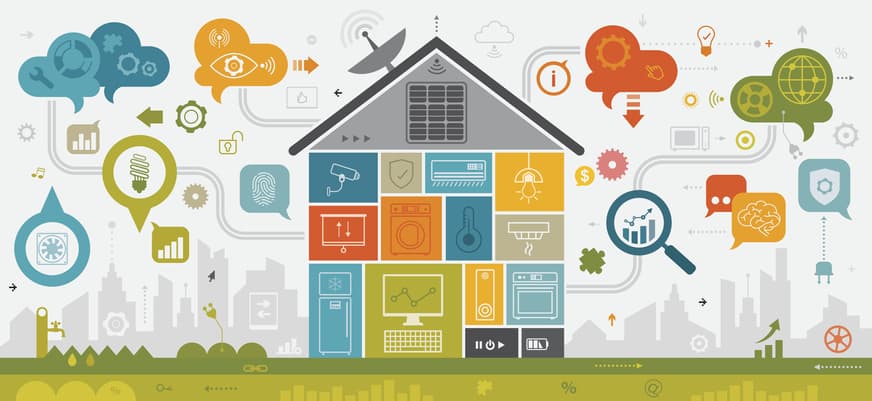By Henrik Christensen, PhD, Qualcomm Chancellor's Chair in Robot Systems, Director Contextual Robotics, UC San Diego; ROBO Global Strategic Advisor
More than 25 years ago, I found myself, once again, sitting at a conference watching a presentation by a major consulting firm. But this one was different from anything I’d seen before. The video showed what was then a fantastical scene of a woman getting ready for work. Standing in her kitchen, she told her coffee maker to brew a hot cup of coffee. She turned to her refrigerator and told it to add milk to the grocery list. She then switched on her computer for a quick video meeting with her team—all of whom were visible online as they discussed the day ahead. As she headed out the door, she asked, “What’s the weather today?” A voice that came seemingly from the heavens told her to go grab an umbrella: there was rain in the forecast. As a roboticist myself, the technology didn’t surprise me; I knew everything I was seeing was available in some shape or form at the time. What did surprise me was seeing that technology being applied in the real world—and not in an industrial setting, but in the home.
Looking back, it’s almost shocking that it actually took so long for AI to find its way in through the front door. But now that it’s here, the reality is even more impressive than what I saw in that once futuristic video.
Today, there are more than 10 million AI-assisted vacuum cleaners in use, and that number is growing every day. iRobot was the first to introduce an autonomous vacuum, the Roomba, back in 2002. Its newest models include Imprint™ Smart Mapping Technology, which uses machine learning to adapt to the specific cleaning needs of each room in your home, and the new iRobot mop. iRobot’s bots can navigate around furniture; clean rugs, hardwood, and tile; and can even be voice-controlled through Alexa or Google Assistant. And while Dyson’s newest vacuum cleaner may not run so independently, it does use complex AI algorithms to determine the level of suction power needed as you clean your house. There are also AI-driven window washers, stove-top cleaners, and self-cleaning litter boxes. If there’s something that needs to be cleaned, AI is coming to the rescue.
Cleaning, of course, is just one way AI is making our homes more efficient. Amazon’s suite of Echo products, all armed with the Alexa speech interface, can now do everything from play your favorite music to control your lights, check on your family anywhere in the world via live video, manage your calendar, and order nearly anything you can imagine from Amazon. Google Home and its Google Assistant can also give you music, news, and weather on demand, and while it doesn’t yet offer the home management tools supported by Echo, it is at the ready to help do everything from start your washing machine (on the right setting, too!) to turn on your shower in the morning—before your toes even touch the floor.
AI is also becoming popular for home climate control. Products like Nest offer smart doorbells (complete with real-time video, a 3-hour recorded history of what took place on your doorstep, and even face recognition software to keep you safe), Wifi-enabled smoke and CO alarms, smart thermostats that learn what temperature you like and then build a schedule around you, as well as door locks and more.
AI is also helping to keep the elderly safe in their homes. Remote monitoring solutions are now available that combine AI and wearable devices to monitor vital signs from the comfort of the home. Other devices use AI to spot changes in activity levels and behavior patterns and automatically request help if the user has fallen or become ill. Solutions from Amazon Echo and Orbita Health support adherence to medication regimes and home healthcare routines, and virtual caregivers—which are already in use in a growing number of healthcare facilities—will soon be coming into the home to help the growing elderly population who is choosing to “age in place.”
RELATED: AI is coming! Investors: Are you ready?
It seems new AI-driven tools for the home are being introduced every day. Thermomix saves time by changing the way home chefs chop, steam, blend, grind, and cook entire meals. AI-enabled scales tell you not only how much you weigh, but also analyze your body fat, measure your water weight, and give you other statistics like bone and muscle mass, body age, basal metabolism, and more. And expect a new member of the family soon in the form of an AI personal assistant. Today’s winners include household robots with smart social skills, and products like the Beam System that allows you to video chat with family and friends from almost anywhere. Tomorrow’s options are likely to be better conversationalists and offer skills that will further transform your home—and your life—using the power of AI.
For investors, the growing prevalence of AI in the home presents a tremendous opportunity. Not only are the makers of each of these innovations poised for future growth, but the underlying technologies that make them possible—machine learning, computing and AI processing, sensing, actuation, voice recognition, and more—are being applied in a wide variety of products, both in the home and across a vast landscape of industries. As the focus on AI and Big Data continues to expand, so will the prospects for investors who recognize and act on this inevitable trajectory today.
Also in this series by Henrik Christensen, PhD:

